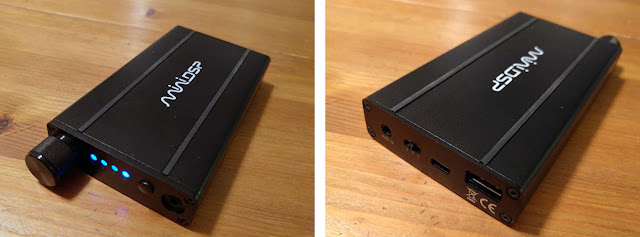Mikhail Naganov
MiniDSP HA-DSP First Impressions
Being an audio geek I couldn’t ignore this promising gadget from MiniDSP. To me, MiniDSP products were always associated with loudspeaker and room digital correction, but unexpectedly they have tried their design skills in a relatively niche area of portable DACs and headphone amplifiers. And thanks to their vast DSP experience, the resulting product has come out very interesting and highly unique.
There is a very good description of HA-DSP from the manufacturer. I will give my own version of it, coming from the possible range of functions that this device can perform:
- HA-DSP can be used as a regular portable headphone amplifier taking analog input. Unfortunately, HA-DSP can’t also be used as a power bank despite presence of a deceptively looking USB-A port on it.
- Since HA-DSP has USB inputs and is USB Audio Class compliant, it can also be used as a portable DAC for mobile devices and computers. However, I’ve encountered issues when I tried using it with some Android devices leading to mobile device reboots.
- The 3.5 mm analog input port of HA-DSP also accepts mini-TOSLink jack, allowing to connect HA-DSP to audio gear that has optical output. Note that both analog and optical input has a cutoff frequency at 22050 Hz, even if the output device provides a full range signal.
However, you can find numerous other portable DACs that can fulfill all these scenarios and don’t have the drawbacks I’ve mentioned. What makes HA-DSP unique is the “DSP” part in it’s name. If you know how to create FIR and IIR filters, this little box offers a lot of room for audio experiments, for example:
Make precise output frequency response adjustments using 10 bi-quad IIR filters per channel.
Create arbitrary crossfeed effects with two parallel blocks of FIR filters and cross-commutation.
Apply headphone target curve correction with FIR filters.
Switch between 4 configurations of the filters that can be tied to different headphone models and crossfeed settings.
My own plan for this box is to replicate Phonitor Mini crossfeed filter, and also to experiment with headphone correction based on the headphone measurements from Inner Fidelity database and Isone MorphIt filter.
I’ve already mentioned some drawbacks of HA-DSP. Another issue I discovered while making measurements is some non-linearity of the frequency response. My measurements of HA-DSP using MOTU Microbook IIc have shown early roll-off in high frequency range. Below is a frequency response of HA-DSP (blue) compared to Microbook’s own (orange):
On this graph, the HA-DSP’s response plot uses Microbook calibration from a loopback measurement. The good part, however, is that this roll-off can be corrected using the on-board DSP as part of FIR filters design.
Conclusions
HA-DSP is definitely a device targeted to audio geeks. One would probably need to carefully consider whether they would be able to use it to full extent. If designing filters isn’t your hobby, there are definitely better alternatives in terms of cost and quality.

